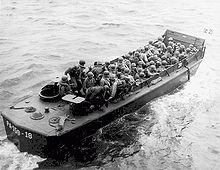Andrew Jackson Higgins and the Eureka Boat
Andrew J. Higgins was the brusque, outspoken, bourbon loving, red tape hating founder and owner of New Orleans based Higgins Industries.
He was described by Dwight D. Eisenhower as “…. the man who won the war for us… if Higgins had not designed and built those LCVPs (landing craft, vehicle, personnel), we never could have landed over an open beach. The whole strategy of the war would have been different.”
America’s nautical savior was born in 1886 in Columbus, Nebraska. His early years were spent on the banks of the Platte and Loup Rivers. Both rivers were shallow and full of sandbars. Only shallow draft boats could navigate its waters. It is thought this is where Higgins’s interest in this type of watercraft began.
In the basement of his parent’s home, Higgins constructed his first boat. A minor detail of being unable to move the finished boat from the basement to the outdoors due to its size was remedied in typical Higgins style: he knocked down the wall that stood in his way.
His inborn desire for independence and self-confidence showed up early. He was thrown out of prep school for brawling and never looked back.
After a stint in the Nebraska National Guard, he moved south to pursue opportunities in the lumber business. He saw a market with oil drillers and trappers who operated in the waters of the Gulf Coast seaboard. In 1926, he developed a shallow draft boat with a recessed propeller in the stern and a “spoonbill” bow so the craft could slide over submerged obstacles and flotsam without jamming the propeller and a “spoonbill” bow so the craft could be run up on riverbanks.
But Higgins Lumber and Export Co. faced stiff competition from larger lumber companies that ultimately put them out of business in 1930.
Nevertheless, the indefatigable Higgins kept the boatbuilding side of his business and began constructing motorboats, tugs and barges for private firms. He also could count the U.S. Coast Guard as a client.
Lady Luck smiled on the hard-charging Higgins.
The U.S. Marine Corps was always interested in finding better ways to get men across a beach in amphibious landings. After twenty years of dealing with failure by the U.S. Navy’s Bureau of Ships and the frustration that The Bureau of Construction and Repair could not meet their requirements, they became interested in Higgins’s boats. He produced a prototype that met the design requirements of the USMC in 60 hours. He called it the “Eureka” boat. It was a plywood, shallow-draft, barge-like rear engine craft and it out-performed the Navy-designed boat. The military called it the “Higgins Boat.”
The only drawback to its design was that the troops on board had to climb over its side to disembark, thus exposing them to enemy fire in a combat situation.
The Japanese, meanwhile, had developed ramp-bowed boats for use in the Sino-Japanese War since 1937. U.S. Navy & Marine observers showed a picture of one to Higgins. It featured a front ramp for troop disembarkation. He immediately got on the phone to his chief engineer, described the Japanese design to him and told him to have a mock-up built for inspection upon his return to New Orleans.
In a month, successful tests of the ramp-bowed Eureka boat on Lake Pontchartrain convinced Higgins and the military this was the answer.
At thirty six feet stem-to-stern with a 10ft, 10inch beam (widest point of the vessel), all plywood, a rear-mounted 225 hp diesel engine, with less than a three foot draft, it could make twelve knots in calm water.
In later designs, the front ramp extended the with of the craft and two .30 cal. machine guns were added aft. It could hold a 36-man platoon of men in full battle dress or a jeep and a twelve-man squad. Helmed by a four man crew, it was possible for a boat to rush onto shore, disembark men and supplies, reverse itself off shore and head back to a supply ship in three minutes.
The little boats were used in all major invasions of the war – Sicily, Italy, North Africa, Normandy and the islands of the Pacific. In the course of the war, Higgins Industries turned out over 20000 such vessels and added to its repertoire with fast PT boats, twenty-seven foot airborne lifeboats which could be dropped from a bomber and 56 foot tank landing crafts.
All the while, Higgins fought running battles with the Bureau of Ships, the Washington bureaucracy and powerful eastern shipyards.
“If the Navy wants something sensible, why the hell don’t they just listen to people like us who have had years of experience?”
—- Andrew Jackson Higgins
The Higgins boat changed modern warfare forever. The Allies now had an easily replacable, formidable tool that eliminated the need for established harbors or minesweepers prior to landing an assault force.
After the war, Higgins was socked with an IRS investigation and was largely forgotten by the public and military.
The inventor of some 30 patents relating to amphibious landing craft, the tough, straight-ahead, hot-tempered old boat-builder passed away on August 1, 1952. He was buried in Metairie Cemetery, just outside of New Orleans.
In 1987, the fleet oiler USNS Andrew J. Higgins was named in his honor and a statue of his likeness in Columbus, Nebraska.
Precious little recognition for “…the man who won the war for us….”


